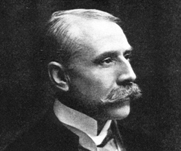Edward Elgar (1857-1934)
Born June 2, 1857 in Broadheath, (near Worcester) England.
Died February 23, 1934 in Worcester.
Serenade for Strings in E minor, Op. 20
Composed 1888 – May 1892.
Instrumentation: Violins I & II, Viola, Violoncello, Bass.
Duration: ~ 12 minutes.
The Serenade is possibly a re-working of the now lost Three Pieces for String Orchestra that was performed by the Worcestershire Musical Union on May 7, 1888. The Serenade as we now know it was completed in May 1892. Elgar led the Worcester Ladies’ Orchestral Class, which privately premiered it. The slow movement was heard on its own in Hereford in 1893, but the first complete public performance did not occur until July 23, 1896 in Antwerp. Its first complete English performance was given July 16, 1899 in New Brighton, and then later published that year. It is the earliest of his works to become well known, and to become part of the standard repertoire.
At this time, Elgar was actively performing as a violinist of considerable ability in local orchestras. His inside knowledge of string technique is apparent in this work. For example, he varied the texture so the solo instruments would still be heard over the full ensemble and in many places, the melody was divided into octaves to become more prominent.
He was pleased with the final product commenting to his friend Arthur Jaeger, whom he immortalized in the Enigma Variations, that it was “Really stringy in effect.” The Serenade remained one of Elgar’s favorite works, and he included it in the last of his recordings of his own music, made on August 29, 1933 with the London Philharmonic Orchestra.
The Serenade is in three movements:
- Allegro Piacevole 6/8
- Larghetto 2/4
- Allegretto 12/8
The opening Allegro Piacevole movement begins in E minor with the violas playing a dotted-rhythm motif that recurs throughout the movement and unifies the work with reappearance in the last movement. The movement is in a simple ABA form. In the lovely Larghetto middle movement we hear Elgar’s ability to achieve an elegiac mood and lyrical poignancy that would later elevate his famous Nimrod (a tribute and portrait of Arthur Jaeger) to Britain’s national song of mourning.
The Allegretto finale begins with a flowing G major melody that contains echoes of the dotted-rhythm motif as a foreshadowing, for the work ends “come prima”, as it began, with a restatement of the opening dotted motif, this time in E major, bringing the work to a seraphic ending.
Resources
Public Domain Score at IMSLP.

One Reply to “Elgar: Serenade for Strings, Op. 20”